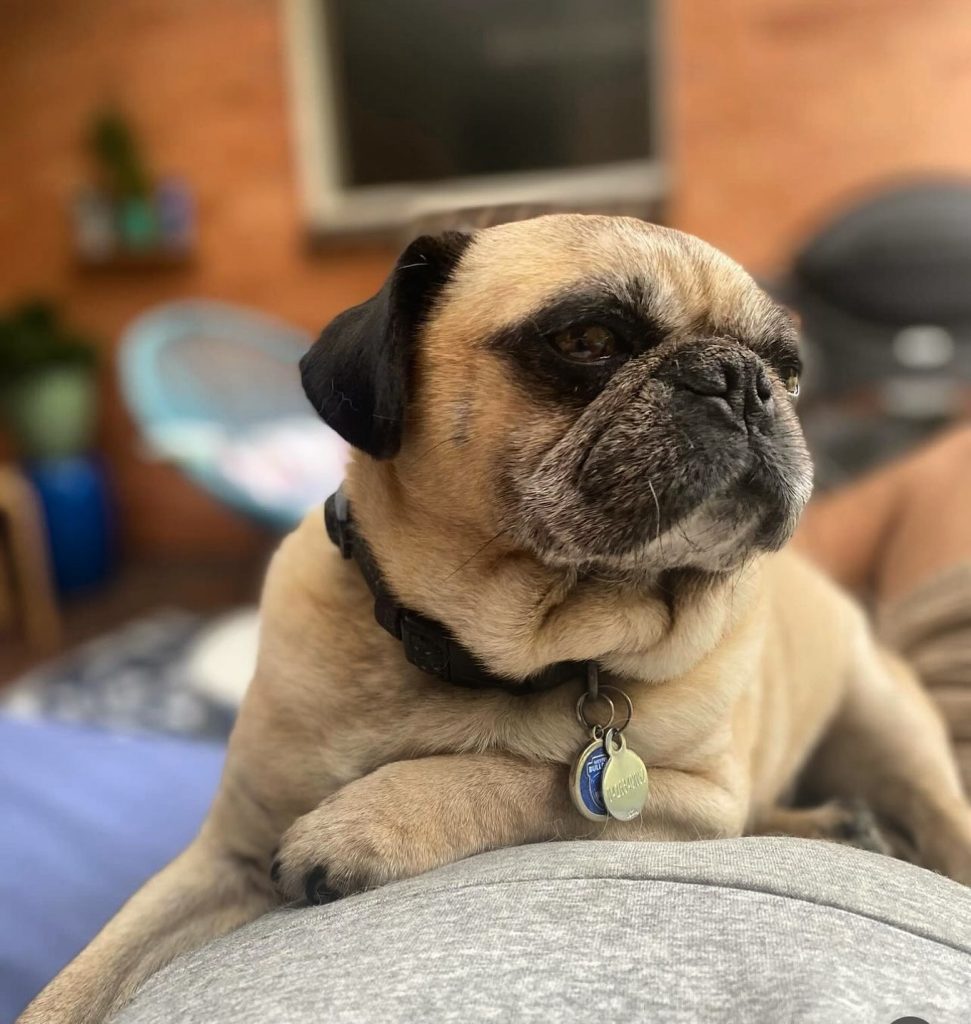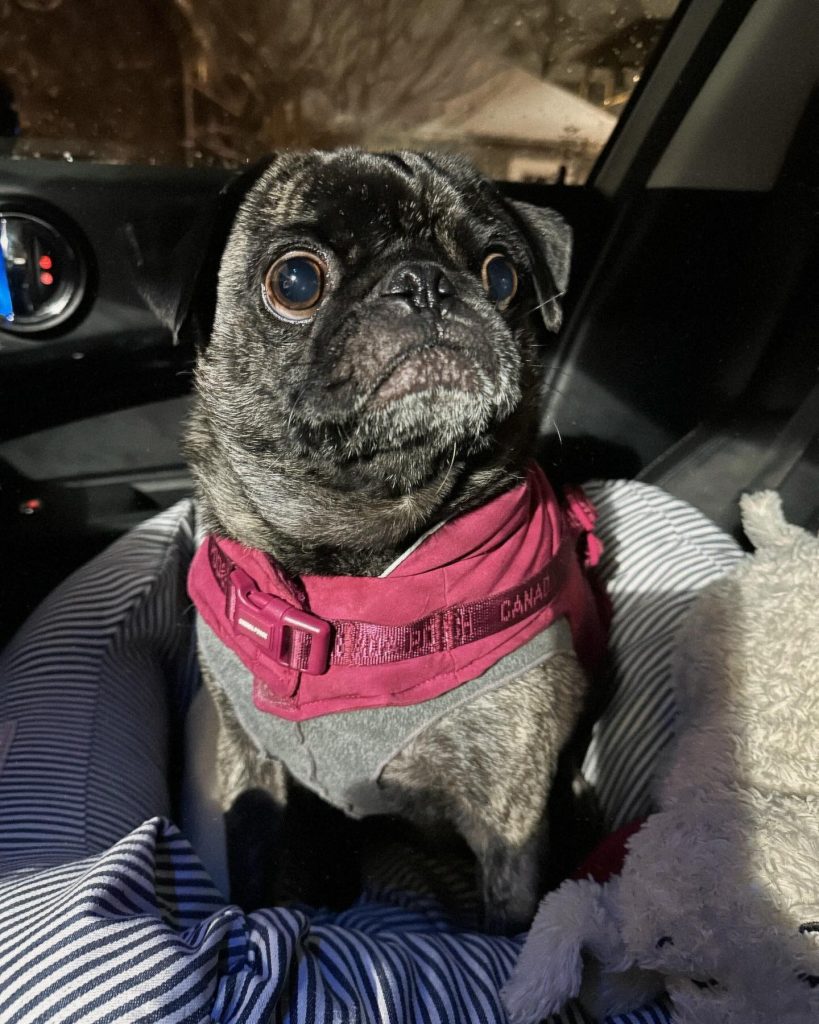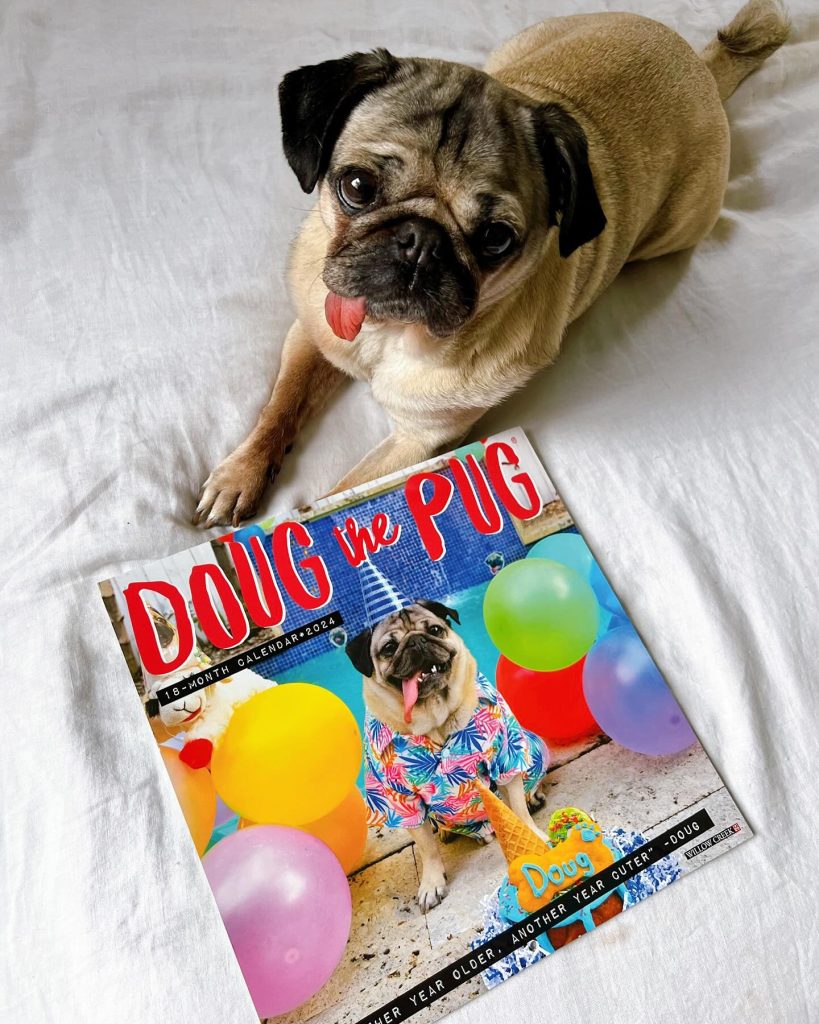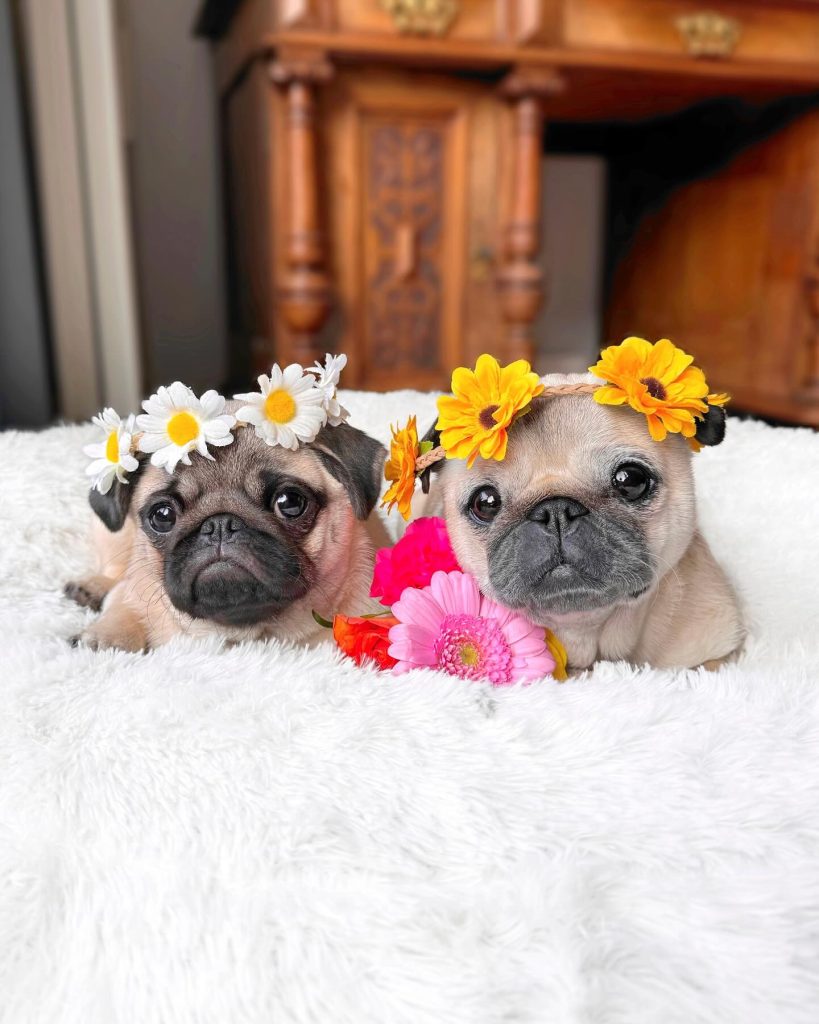Introduction: Understanding Your Pug Puppy
Pugs are more than just pets; they are personalities on four legs, characterized by their wrinkly, short-muzzled face and curled tails. This section will delve into the unique aspects of pugs, their historical background, and the way they express affection, which can significantly influence how they are trained and cared for.

The Unique Qualities of Pugs
Pugs are known for their distinctive features and charming personalities. They possess a compact body, a distinctive wrinkled face, and a curled tail that sits tightly over their hip. These physical attributes are complemented by their expressive, large, dark eyes that seem to be filled with depth and understanding. Pugs are renowned for their sociable nature; they are friendly, affectionate, and thrive on human companionship. Unlike some other breeds, pugs are less prone to aggression and more inclined towards making friends, be it with humans or other animals. Their sense of humor and love for play make them an ideal family pet, suitable for households with children and other pets. However, their unique physical structure also necessitates specific care, particularly regarding their respiratory system and maintaining a healthy weight to avoid stress on their compact frame.
The History and Origin of Pugs
The history of pugs is as rich and fascinating as their personalities. Originating from China, pugs have a storied past that dates back to the Han dynasty (B.C. 206 to A.D. 200). Initially bred to be companions for ruling families, Chinese emperors highly valued pugs, and their care was attended to by the imperial guard. The breed later made its way to Europe in the 16th century through Dutch traders. The pug quickly became a favorite among European nobility, including in the Netherlands, where they were the official dog of the House of Orange. Queen Victoria of England also had a well-documented fondness for pugs, which she bred herself. The breed’s popularity has endured, with pugs becoming beloved pets around the world, appreciated for their loyal and affectionate nature.
The 5 Love Languages of Pugs
Understanding how pugs give and receive love is crucial for any pug owner. Much like humans, pugs have their unique ways of expressing love and affection, which can be categorized into five main “love languages”:
- Quality Time: Pugs crave attention and enjoy spending time with their owners, whether it’s cuddling on the couch or accompanying them on errands.
- Physical Touch: They love to be close to their owners, often seeking out laps or leaning against their legs. Gentle petting and massages are particularly appreciated.
- Acts of Service: For a pug, acts of service involve meeting their needs in a way that they understand and appreciate, such as regular feeding, grooming, and ensuring they have a comfortable living space.
- Words of Affirmation: Speaking to pugs in a gentle and reassuring tone strengthens the bond between pet and owner. They might not understand the words, but they certainly pick up on the tone and intention.
- Gifts: While not materialistic, pugs do enjoy the occasional treat or new toy. This not only serves as a reward but also as a token of love from their owner.
By recognizing and understanding these love languages, owners can foster a deeper, more meaningful relationship with their pug, ensuring a happy and content companion.

Preparing for Pug Training
Training a pug requires patience, understanding, and the right approach from the very beginning. Whether it’s pug crate training, overcoming their occasionally stubborn nature, or toilet training, setting a solid foundation is crucial for success.
Optimal Age to Begin Training
The journey of training a pug puppy should ideally start as soon as they arrive in their new home, typically around 8 weeks old. This is the golden period for imprinting behaviors and setting the groundwork for basic commands and potty training. Starting early capitalizes on a pug’s formative weeks, where they are most receptive to learning and adapting to their environment.
Essentials for Training Your Pug
Key to any training regimen, particularly when tackling how to train a stubborn pug or initiating pug puppy toilet training, are consistency, positive reinforcement, and the right tools. Essential items include a comfortable crate for pug crate training, which aids in establishing a routine and a safe space for your pug. Additionally, treats for positive reinforcement, a consistent schedule, and a designated toilet area are crucial. Training sessions should be short, engaging, and filled with encouragement to cater to a pug’s attention span and to maintain their interest in learning.
The Fundamentals of Pug Training
Training a pug, with their distinctive personalities and unique needs, can be a rewarding endeavor. Despite the challenges, such as the common question “why are pugs so hard to train?”, with the right approach, training your pug can be a successful and fulfilling experience. This section explores the foundational principles of effective pug training, from the importance of starting early to the critical role of socialization.
Start Training Your Pug Early
Initiating training at a young age is pivotal for any puppy, and pugs are no exception. Early training sets a precedent for future learning and behavior. For tasks like toilet training, which is often a concern for new owners wondering about how to train a pug puppy for the toilet, starting as soon as your pug arrives home is ideal. This early start takes advantage of a puppy’s developmental stage, where they are most malleable and open to learning new habits.
The Importance of Consistency
Consistency is the cornerstone of effective training. This means maintaining a steady routine, using the same commands, and applying the same rules and boundaries each day. Consistency helps your pug understand what is expected of them, reducing confusion and aiding in quicker learning. This is particularly important for pugs, given their reputation for being somewhat challenging to train.
Embracing Positive Reinforcement
Positive reinforcement is a powerful tool in training any dog, including pugs. This method involves rewarding desired behaviors with treats, praise, or play, which encourages the dog to repeat those behaviors. For tasks like potty training, where owners often wonder, “Are pugs easy to potty train?”, positive reinforcement can be particularly effective, as it helps build a positive association with the correct behavior.
The Benefit of Short Training Sessions
Pugs, with their short attention spans, benefit greatly from brief, focused training sessions. Lengthy sessions can lead to frustration and boredom, reducing the effectiveness of the training. Keeping sessions short, around 5 to 10 minutes, ensures that your pug remains engaged and interested in learning. This approach is also beneficial for busy owners, allowing training to be more easily incorporated into daily routines.

Using Clear and Simple Commands
The use of clear and simple commands is crucial in training pugs. Complex commands or inconsistent language can confuse your pet, hindering their learning process. Commands should be concise, consistent, and used alongside a clear gesture or signal to help your pug understand and respond appropriately. This clarity helps in addressing behaviors like biting, where owners might seek advice on how to train a pug puppy not to bite.
The Value of Patience in Training
Patience is perhaps one of the most important virtues when training a pug. Given their sometimes stubborn nature, it’s crucial to approach training with a calm and patient demeanor. Frustration and anger can negatively impact the training process, causing anxiety and fear in your pet. Patience fosters a positive learning environment, encouraging your pug to try their best without fear of reprimand.
The Role of Socialization
Socialization plays a vital role in the overall development and training of your pug. Exposing your pug to various people, pets, and environments from a young age helps them become well-adjusted and confident adults. Socialization aids in reducing fear and aggression, making other training aspects, like leash training or public behavior, much smoother. It also helps mitigate behavioral issues that might stem from fear or anxiety, creating a more sociable and friendly pet.
In conclusion, training a pug requires a blend of early start, consistency, positive reinforcement, short and engaging sessions, clear communication, patience, and thorough socialization. While pugs may present certain training challenges, understanding their needs and tailoring the training accordingly can lead to a well-behaved and happy companion. Remember, every pug is an individual, and what works for one may not work for another, so be prepared to adapt and find what best suits your furry friend.
Advanced Training Techniques and Goals
As your pug progresses through the basics of training, it’s time to move on to more advanced techniques and set new goals. This stage involves refining your pug’s behavior, teaching complex commands, and ensuring they can behave well in a variety of situations.
Redirecting Unwanted Behaviors
Unwanted behaviors in pugs, such as excessive barking, chewing, or jumping, can often be managed by redirecting their attention to a more desirable activity. For instance, if your pug tends to chew on inappropriate items, offer them a chew toy instead. This technique not only stops the unwanted behavior but also teaches your pug what is acceptable to chew on. The key is to intervene early and consistently, ensuring your pug understands the redirection.
Setting Realistic Training Expectations
It’s important to set realistic expectations for both you and your pug during the training process. Here are a few pug training tips to keep in mind:
- Patience is Key: Remember that progress might be slow and incremental. Celebrate the small victories along the way.
- Understand Your Pug’s Limitations: Pugs have unique physical and mental characteristics that might affect their training capabilities. Adjust your expectations accordingly.
- Consistency Matters: Training needs to be a regular, consistent part of your pug’s routine. Inconsistent training can lead to confusion and slower progress.
- Use a Variety of Rewards: Pugs can be food-motivated, but also respond well to praise and play. Varying the rewards can keep training sessions engaging and effective.
- Seek Professional Help if Needed: Don’t hesitate to consult a professional trainer or behaviorist if you’re facing persistent challenges.
Avoiding Punishment-Based Techniques

Punishment-based training methods can harm your relationship with your pug and lead to fear or aggression. Instead, focus on positive reinforcement and redirection to teach desired behaviors. If a behavior needs to be corrected, use a firm “no” or a time-out method rather than physical corrections. This approach fosters a trusting bond between you and your pug and makes training a positive experience.
Essential Commands: “Leave It” and “Drop It”
Teaching your pug the “Leave It” and “Drop It” commands is crucial for their safety and your peace of mind. These commands help prevent your pug from picking up or chewing on dangerous objects and are indispensable in managing their curiosity.
- Leave It: Start with a treat in your hand and let your pug sniff it. Close your hand and say “Leave It.” Once they stop sniffing and move away, reward them with a different treat. Gradually increase the difficulty by using more enticing items and moving them to the floor.
- Drop It: When your pug has an item in their mouth, offer them a treat and say “Drop It.” As they drop the item to get the treat, praise them enthusiastically. Practice this command with different objects to ensure your pug understands the command in various contexts.
Incorporating these advanced training techniques and goals into your pug’s routine will enhance their obedience, safety, and overall well-being. With patience, consistency, and a positive approach, you can achieve remarkable training milestones with your pug. Remember to consult a pug training guide if you need more detailed instructions or encounter specific challenges.
Training Milestones & Timeline
Training a pug involves various stages, each with its milestones and objectives. Understanding these stages can help you navigate the training process effectively, ensuring your pug develops into a well-mannered and sociable companion.
Early Growth Stage: 8-16 Weeks
Basic Commands and Socialization Goals
During this foundational stage, focus on simple commands such as “sit,” “stay,” “come,” and “down.” These commands lay the groundwork for more complex training in the future. Socialization is also critical at this age; expose your pug to different people, pets, and environments to foster a well-adjusted and confident adult dog. Aim for positive experiences to build a solid foundation for their social skills.
Puppy Stage: Up to 6 Months
Advanced Commands and Leash Training
As your pug progresses, start introducing more advanced commands, such as “leave it” and “drop it.” These commands are essential for their safety and your peace of mind. Leash training also becomes crucial during this stage. Begin with short, positive leash-walking sessions inside or in a quiet outdoor area. Gradually increase the complexity and duration of these sessions as your pug becomes more comfortable and responsive.
Beyond One Year: Ongoing Training
Continuing training beyond the first year is vital for maintaining and refining the skills your pug has learned. Focus on reinforcing commands, improving leash behavior, and addressing any new or unresolved behavioral issues. This stage is also an excellent time to engage in more complex training activities or dog sports, which can provide mental stimulation and strengthen the bond between you and your pug. Regular, ongoing training ensures your pug remains well-behaved and adaptable to new situations throughout their life.
Overcoming Common Training Challenges
Training a pug can come with its unique set of challenges. Understanding these challenges and how to navigate them is key to a successful training regimen.
Understanding What Pugs Are Bred For
Pugs were originally bred as lap dogs, companions to royalty and nobility in ancient China. This breeding for companionship means they thrive on human interaction but can also exhibit a stubborn streak, which might present a challenge in training. Recognizing this inherent trait can help adjust your expectations and approach.
Adapting Training Techniques Based on Pug Behavior
Adapting your training techniques to suit your pug’s personality and inherent traits is crucial. For example, their desire for companionship can be leveraged to encourage positive behaviors through praise and affection. Their occasional stubbornness may require more patience and repetition. Understanding and working with your pug’s natural inclinations, rather than against them, can greatly enhance the effectiveness of your training efforts.
Week-by-Week Training Schedule for Your Pug
A structured training schedule is essential for your pug’s development. This guide outlines a week-by-week plan to help you and your pug through the critical early stages of training.
Weeks 1-8: From Sleep Training to Socialization
Start with the basics: sleep training and crate training to establish a routine. Gradually introduce basic commands like “sit” and “stay.” Prioritize socialization by exposing your pug to various environments, people, and other pets in a controlled and positive manner. This foundational period sets the stage for a well-adjusted and obedient pug.

What to Expect Next: Continuing Your Pug’s Education
After the initial 8 weeks, continue building on the foundation with these key focuses:
- Reinforce Basic Commands: Ensure commands learned in the first 8 weeks are practiced and reinforced.
- Advance Training: Gradually introduce more complex commands and tricks.
- Leash Training: Focus on leash manners and walking etiquette.
- Behavioral Corrections: Address any emerging undesirable behaviors immediately.
- Ongoing Socialization: Continue exposing your pug to new situations to maintain their social skills.
Recap: Key Takeaways from Pug Training
Successful pug training hinges on consistency, patience, and understanding your pug’s unique personality and needs. Establishing a routine, using positive reinforcement, and adapting to your pug’s learning pace are crucial elements. Remember, the goal of training is not just obedience but also fostering a happy, healthy relationship with your pug.
